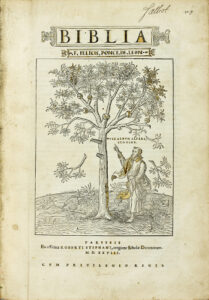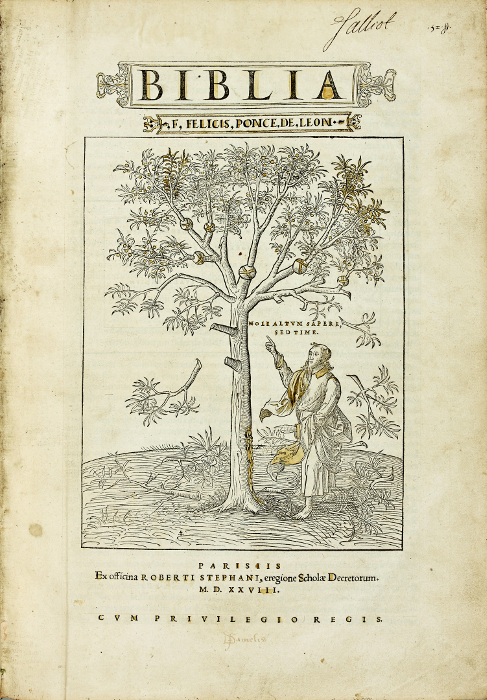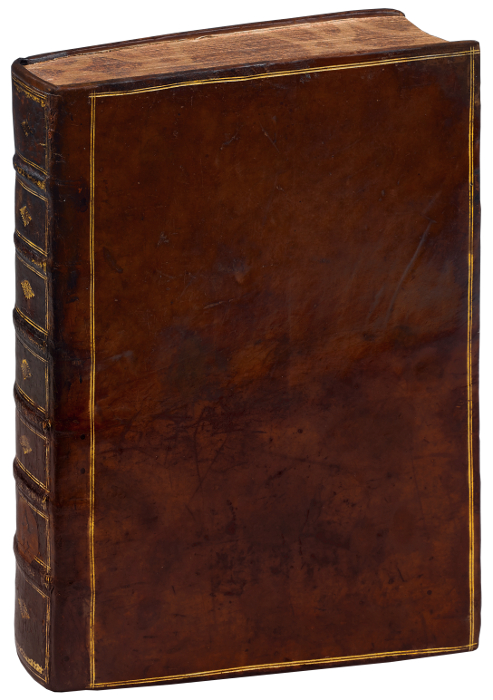Paris, R. Estienne, 1528 (colophon : 28 November 1527).
Folio [347 x 240 mm] of (10) ll., 394 ll. (misnumbered 390), (90). Small tear l. 216. Full blond calf, double gilt fillet on the covers, spine ribbed, painted edges. Binding from the early 17th century.
“The monumental first Estienne Edition of the bible as well as Robert Estienne’s first project as a scholar-printer” (Schreiber). Harvard, French, 65. “More than once, Francis I and his sister, Marguerite de Valois, paid unexpected visits to Robert Estienne’s printing house… Francis I was very fond of Robert; he appointed him his official printer for Hebraic and Latin languages in 1539, then for the Greek language, after the death of Conrad Néobar in 1540.
In 1528 Robert Estienne published his great Latin Bible, after Saint Jerome’s version. In order not to leave anything to chance in such a delicate work, he had compared the text of the most ancient manuscripts from the King’s Library and the abbeys of Saint-Germain-des-Près and Saint-Denis, with the printed editions and mostly with the Complutensian Polyglot Bible. This titanic work cost him ten years. He added lists of contents before the chapters, marked the verses, put in the margin similarities and variations related to the Hebrew text, re-established the proper Chaldean, Hebrew, Greek and Latin names disfigured in the previous editions, and ended his work with an index giving in these different languages the proper names of the men, women, people, towns, idols, rives, mountains and other places presents in the Old and New Testament. King Francis I’s privilege, given in Paris on February 4th 1527, and reproduced in French at the end of the work, says this Bible was printed with the agreement and after careful consideration and experience of people of great knowledge; which did not prevent the Sorbonne’s doctors from persecuting once more Robert, who would have inevitably given up without the King’s protection. According to the report that has been made, Robert Estienne gave eleven editions of the entire Bible, as much in Hebrew as in Latin and in French. We can judge there the immensity of his work and of the services he gave to the biblical studies.” (P. Larousse).
“Robert Estienne (1503-1559) first used the same characters as his father and Simon de Colines; but he had engraved in a far more elegant way some that he used, for the first time, in the beautiful edition of the Latin Bible, published in 1528. Estienne had not left anything to chance in order to make a master-piece of his art.”
“Every typographers of the French Renaissance cut a sad figure next to Robert Estienne… For him as for Lefèvre d’Etaples or Erasmus, it was most of all important to provide strong foundations for the renewal of the religious thought. Robert had, as we have seen, started very soon to care about it. As soon as 1528, he was able to give a folio edition of the Vulgate, revised and accompanied with a series of indexes and tables.” (Henri-Jean Martin). “Each one of these entire or partial editions of the Bible was in Robert’s typographical career an event of a real importance, either for what it added to his reputation, either, and even more, it is unfortunate to have to tell it, because of the regrettable results for his tranquility and his well-being. We noticed that since several years he was working on a complete edition of the Latin Bible: in 1527 he had obtained the privilege, and was published the following year in a folio volume.” “This is Robert Estienne’s first major work – also his first folio publication – and the book which immediately established him as the most outstanding figure in the Paris booktrade of his time. In this monumental volume there appears for the first time Robert Estienne’s large olive-tree device. This volume also marks the first use of Geoffroy Tory’s two sizes of beautiful criblé initials (cf. Bernard, Tory, 185-89; A. F. Johnson, Decorative Initial Letters, n° liii).” (Fred Schreiber) A precious copy preserved in its elegant early 17th century binding with painted edges, with the yellow rubricated capitals, of fine provenances: Feliz Ponce de Leon ; D. Famelis ; Salliot, Madame la Comtesse des Courtils ; Macneil ; Los Angeles ; Dawson 1949 ; Estelle Doheny (1875-1958).



